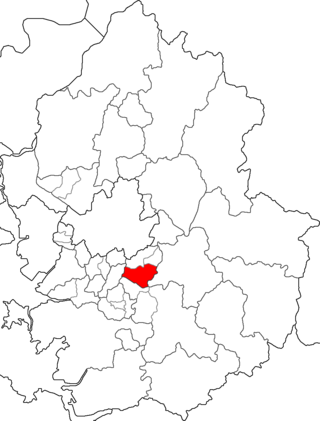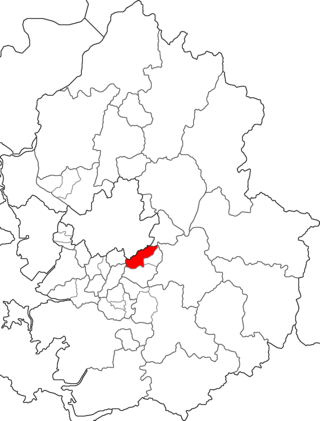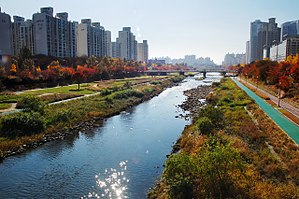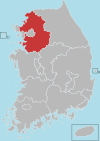
Gyeonggi Province is the most populous province in South Korea.

Yongin is a city in the Seoul Capital Area, the largest in Gyeonggi Province, South Korea. With a population over 1 million, the city has developed rapidly since the 21st century, recording the highest population growth of any city in the country. Yongin is a multi-nuclear city with multiple urban centers, not a single nuclear structure, and Giheung District crosses the Yeongdong Expressway and Dongbaek, while Suji District crosses Pungdeokcheon Stream and Jukjeon.

Gwangju is a city in Gyeonggi Province, South Korea, a suburb southeast of Seoul. The city is not to be confused with the much larger Gwangju, former capital of South Jeolla Province, or Guangzhou, the city of Guangdong, China in Hanja.

Bundang District is the largest and most populous district (gu) of Seongnam, a major city in the Seoul Capital Area, South Korea. Bundang District is one of South Korea's wealthiest and highest developed areas, being the nation's first and largest completely artificial city built in the early 1990s. Many high-rise luxury condos moved in the early 2000s, with a second planned city built in the late 2000s called Pangyo in the same district. Apartment prices are the second highest in Gyeonggi Province after Gwacheon and 7th highest nationwide, higher than many central Seoul districts such as Mapo District or Jongno District. Apartments around Pangyo station and the high-rise luxury condos around Jeongja station and Sunae station rival prices in the most expensive areas in the country. Unlike older cities such as Seoul, Bundang has no telephone poles overground, resulting in a clean cityscape with well-designed streets.
Hyundai Department Store (Korean: 현대백화점) is a major department store chain in South Korea. Its parent company is the Hyundai Department Store Group. It, Lotte Department Store, and Shinsegae are the three largest chains in the country.

The Capital Region First Ring Expressway (Formerly as Seoul Ring Expressway) (Expressway No.100) (Korean: 수도권제1순환고속도로; RR: Sudogwon Je1sunhwan Gosokdoro) is an expressway, circular beltway or ring road around Seoul, South Korea. It connects satellite cities around Seoul, Ilsan, Namyangju, Hanam, Pyeongchon, Jungdong, Bundang, Pangyo, Sanbon and Gimpo. The expressway runs 127.6 km. Seoul Ring Expressway is currently under construction to widen the expressway between Anhyeon Junction to Seongnam which is expected to be finished in 2016.

Seohyeon-dong refers to two of the 19 dongs of Bundang-gu, Seongnam, South Korea, Seohyeon-1-dong and Seohyeon-2-dong. The total area is 8.36 km², with a population of 52,950, 32,686 in Seohyeon-1-dong (7.57 km²)[](May 2014) and 20,264 in Seohyeon-2-dong (0.79 km²)[](May 2014). To the south, there is Sunae-dong, to north there is Imae-dong, to west there are Baekhyeon-dong and Pangyo-dong, to east there are Bundang-dong and Gwangju city. It includes the busiest place in Bundang, AK Plaza. Ak plaza's clock tower is the most famous meeting place in Bundang.

Tancheon is a stream in Gyeonggi Province and Seoul, South Korea. The stream is a tributary of the Han River. It begins in Yongin, Gyeonggi Province, flows through Seongnam, and eventually into the Han. It has a total length of 32.66 km (20.29 mi).

Pangyo or Pangyo New Town is a planned district composed of several dongs or neighborhoods of Seongnam, South Korea. It contains Pangyo-dong, Baekhyeon-dong, Unjung-dong, and Sampyeong-dong of Bundang District and Siheung-dong and Sasong-dong of Sujeong District (Seongnam).
Gumi-dong is one of the 19 dongs of Bundang District, Seongnam, Gyeonggi Province. It has total area of 4.77 km2. As of April 30, 2006, there are 38,022 residents in Gumi-dong.

Sujeong District is a district (gu) in Seongnam, Gyeonggi Province, South Korea.

Suji District, or Suji, is one of the three city districts in Yongin, South Korea which is approximately 29 km south of Seoul. Suji became a city district on October 31, 2005, about nine years after Yongin officially became a city. When Yongin was established in 1996, both urban and rural areas were covered to become a part of the city; thus to this day, Yongin's urbanization is varied throughout different regions of the city. Suji is one of the most urbanized areas of Yongin, as it borders Seongnam's Bundang District and Suwon, two more well developed areas. Home to the newly built Shinsegae Department Store and Dankook University in one of its towns, Jukjeon, Suji is rapidly developing as Yongin becomes more and more urbanized. In recent years, the district has attracted upper-class Koreans, with the completion of the Samsung East Palace in 2010.

The Seoul Metropolitan Area or Gyeonggi region, is the metropolitan area of Seoul, Incheon, and Gyeonggi Province, located in north-western South Korea. Its population of 26 million is ranked as the fourth-largest metropolitan area in the world. Its area is about 12,685 km2 (4,898 sq mi). It forms the cultural, commercial, financial, industrial, and residential center of South Korea. The largest city is Seoul, with a population of approximately 10 million people, followed by Incheon, with three million inhabitants.

Pangyo Techno Valley (PTV) is an industrial complex in the city of Pangyo, Seongnam, Gyeonggi Province, South Korea. It is also known as the Silicon Valley of Korea. The complex focuses on information technology, biotech, cultural technology and fusion technology. One of the benefits of the diversity of fields and businesses is the maximized growth potential in the field of high-tech technology through exchanges between the companies. The location within a major metropolitan area creates synergy effects because of the proximity to other techno valleys or adjacent knowledge-based infrastructure clusters in the province. The business environment of the PTV is supported by the government of the Gyeonggi Province through the implementation of various support facilities as for examples a R&D center or public support center.
Sinchon-dong may refer to:
Pangyo Junction, also known as Pangyo JC, is a junction located in Bundang-gu and Sujeong-gu, Seongnam, Gyeonggi, South Korea. It serves as the meeting point of Gyeongbu Expressway and Seoul Ring Expressway. It is named after the new town in which it is located, Pangyo. The type of junction is Changed Y interchange.
The Sejong–Pocheon Expressway, is an expressway in South Korea, connecting Anseong to Guri, Seoul, Namyangju, Uijeongbu and Pocheon.
The Bundang-Suseo Urban Expressway, is an urban expressway in South Korea, connecting Bundang-gu to Sujeong-gu in Seongnam, Gyeonggi Province.
The Bundang-Naegok Urban Expressway, is an urban expressway in South Korea, connecting Bundang-gu to Sujeong-gu in Seongnam, Gyeonggi Province.




















